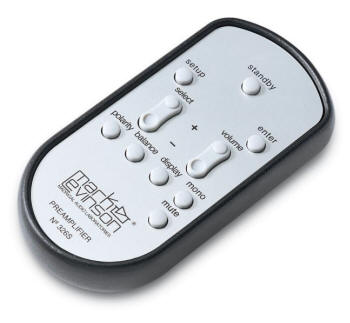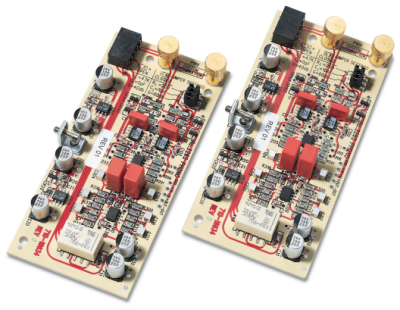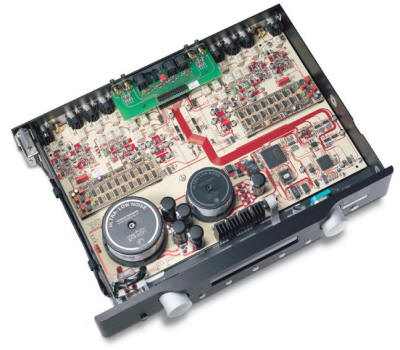The Mark Levinson No326S (326S) solid state stereo preamplifier arrived. After removing 37 staples from the outer box, and opening inner box number one, I found the preamplifier inside a third box. While many audio components are packed to survive a short drop from the back of a delivery truck, it is conceivable that this preamp could be delivered by the U.S. Army into a combat zone without damage. In this case, the package befits the product. The $10,000 326S is the only, at this time, stereo preamplifier from Mark Levinson, a brand of Harman International Industries, Inc. Harman Luxury Audio Group’s other brands include Revel, Lexicon, and JBL.

The preamplifier’s modest size of about 18″ wide x 14″ deep x 3″ high, and weighing about 30 pounds, make for a manageable and attractive component. The Owner’s Manual runs 80 pages, so I recommend a visit to the manufacturer’s Web site (link below) for complete information. Here is a brief list of some of the more welcome features. There are three balanced inputs and four unbalanced inputs, with a single balanced and unbalanced output for each channel. All of the inputs can be individually named so you don’t have to remember what is plugged into “Input 1” or another input. Each input can be adjusted for gain, either 0, 6, 12, or 18dB. Any input can be turned off so you don’t have to cycle through an unused input as you turn the input selector knob. The volume control, which has a wonderfully smooth feel as you turn the large, contoured knob, has a range of 80dB and resolution of 0.1dB. If you like to be able to control the listening volume precisely, then the 326S is worth looking at further. The mute level can be set in 0.1dB increments between –10.0 and –80.0dB. The factory-default mute level is –20.0dB. I like –30dB for the mute level. When mute is turned off, the volume quickly ramps up to the preset level, eliminating the danger of speaker damaging spikes. The nicely sized alpha-numeric readout, which shows the input name and volume level and can be dimmed in several levels, is not too small and not too large.

The two unbalanced tape monitor outputs can be set to output any or all of the inputs. If the on-board phono boards are installed, a $1,400 option, input 7 is automatically assigned to Phono. All of the front panel controls are also on the nicely curved metal-body remote control, including mono, polarity, and input programming. Using the remote trigger, I can turn my entire system on and off from the listening seat, wirelessly. This is a completely modern preamplifier with all of the features and settings one could want or need.
A separate 26 page owner’s manual is included with the optional phono. The preamplifier cover is easily removed by first removing the four feet and sliding the “C” shaped cover towards the rear. The phono’s two identical left and right channel circuit boards measure only 3 7/8″ x 1 3/4″ and make extensive use of surface-mount components. Each board is easily installed to a connector on the preamplifier’s main board and is secured with a screw. The phono boards use jumpers to set the gain at either 40 or 60 dB, and input impedance of either 200 or 47k Ohms. Custom loading is also accommodated. Tools and an anti-static wrist strap are provided. As with the preamplifier, a minimum of 200 hours of break-in is needed to realize the full potential of the phono section.
Other components on hand during the audition included a SOTA Cosmos IV vacuum turntable with Triplanar VII u2 tonearm, SOTA Satellite turntable with Origin Live Zephyr tonearm, Amazon Referenz turntable, Moerch DP-8 Anisotropic tonearm, Miyajima Kansui, Shilabe and Premium Mono phono cartridges, Bob’s Devices CineMag 3440 step-up transformers and Bob’s brand new CineMag 1131 “Blue” step-up transformers, Rogue Ares and Lamm LP2 vacuum tube phono preamplifiers, Prism Orpheus Digital Interface with custom Windows 7 computer/music server, Fritz Speakers REV 5, YG Acoustics Kipod Main Modules speakers, YG Acoustics Kipod II Signature Main Modules (OMG), Dali Mentor 5 speakers (from the home theater system), and Gallo TR-3 subwoofers. Power amplifiers included Modwright KWA 150 Special Edition, Pass X250.5, Parasound JC-1, Levinson 532H, B&K Reference 125.2, Cary SA200.2, and Manley Snappers. Interconnects and speaker cables are mostly Mogami. All front end components, including the preamplifiers, receive their AC power from a PS Audio AV-5000 power conditioner which is connected to the wall power with a 1 meter length of PS Audio PerfectWave AC-10 power cord. Other AC-10s were used elsewhere in the system, and I use Jerry’s DIY power cords on the music computer and Levinson preamp. An Audience aR2p-TO power conditioner or PS Audio Quintet is normally used for the power amplifiers. The Levinson preamplifier rested on three Ayre myrtle wood blocks.

From my review of three preamplifiers: “Besides source switching, the goal of a stereo preamplifier is to provide the widely accepted function of being a straight wire with gain, imposing absolutely no character, change, distortion, or any alteration of the audio signal. The most reliable way to evaluate how successful a preamplifier is at attaining this goal is with bypass testing. Bypass testing allows for adding or removing only the preamplifier from an otherwise unchanging playback system, allowing precise audio inspection of the intrinsic sound of the preamplifier and any deviations from neutrality.” This method of critical evaluation was used for the 326S preamplifier.
This is the most transparent – in the most transparent sense of the term – and neutral preamplifier I have ever heard in my room. There is a very slight “smoothing” of harsh or grainy source material in the upper frequencies, reducing the level of listener fatigue from these sources and increasing listening pleasure. Curiously, this small effect is absent on high quality recordings. Also, images on a sound stage are slightly better focused than the direct signal from the source. The delicacy and resolution in the upper frequencies are completely natural sounding. The bass can be very deep and powerful. Vocals are fully formed and human. The Levinson is not harsh, cold, warm, fat, slow, dry, or thin sounding. It does not favor any particular frequency range or type of music. With average or better source material, the sonic impact of the 326S line stage is negligible. It can realistically be considered to be a non-harmful conduit from source to amplifier. I share this conclusion after owning the preamplifier for about one and a half years. This is not a knee-jerk, rushed, or otherwise half-formed opinion.

The phono section is good when used in specific ways, but not up to the level of perfection of the preamplifier. Still, for $1,400, it is more than competitive. While identifying the nature or character of the line stage is elusive, it is not difficult to determine the solid state heart of the phono section. There is a trace of coolness to the upper frequencies which exacerbates any harshness or distortion from the LP playback components. This includes older vinyl recordings.
However, when I set the phono input to 40 dB of gain and 47k Ohms impedance, and then added the Bob’s Devices CineMag 1131 step up transformer ($895), the Levinson phono gained a significant increase in overall quality and musicality. As with the line section, the frequency balance seems perfectly linear from the low bass to the upper treble. The phono preamp seems to benefit from a stronger input signal than the 0.23mV of my Miyajima Kansui moving coil phono cartridge and delivers a richer, more relaxed, very listenable presentation and much lower background noise when used with the outboard step-up transformer.
I am often a little bit disappointed when I read reviews that have lots of words but very little actual description of the sound of the component under review. The Levinson 326S preamplifier has such a minor effect on the signal passing through that it does not warrant a more exploratory review. It does not sound like a solid state preamplifier nor like a tube preamplifier. There is no weakness in the bass, midrange, or treble. It sounds just as tight, powerful, fast, warm, rich, clear, extended, open, detailed, and 3-dimensional as the source requires. Dynamic impact is stunning. Of all of the preamplifiers I have tried, the 326S easily wins for the best user interface. The build quality of the preamp and remote control are a continuing source of pride and joy of ownership. Operation and reliability have been faultless.
So transparent to the incoming signal and so pure in delivery is the 326S that the preamp would not be the limiting factor, or weak link, in a high resolution audio system. Nothing I have heard for less money comes close. The rest of the system would need to be an order of magnitude – or more – better before suggesting the evaluation of another preamp. Along with this impression goes a challenge to the talented engineers at Harman: You have set the bar so high that the next upgrade will have to be in your design skills if you plan to top this achievement.
The optional phono stage is quite good and fully competitive at its price and above. The Overall Rating below reflects the performance of the 326S line stage.
I tried different cables and power cords, different power conditioners and other tweaks, and a plethora of associated components. Each one had a larger effect on the sound coming out of my speakers than did the Mark Levinson 326S preamplifier. Exceptional neutrality, beautiful physical design, a full-featured but simple user interface that would make fighter aircraft cockpit designers look twice, and reasonable price considering both the level of performance and the competition marks this preamp as a true reference product. Enjoy.
Overall Rating: 10 LPs

Link to Manufacturer’s Web site: Mark Levinson
